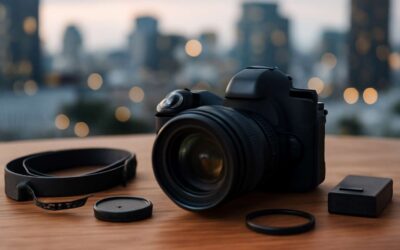Lenses are the pieces of equipment that allow a camera to make pictures or video. They vary in size, shape, and functionality but are all essential for making a photo or video that will stand out from the rest.
Focal Length and Maximum Aperture – The focal length of the lens determines how much of the scene it can capture. A lens with a longer focal length will have a wider field of view than one with a shorter focal length, and the longer the lens, the more the picture will appear to be “zoomed in.”
The maximum aperture of the lens is important because it relates to how much light is let through to the sensor. Wider lenses will let in more light than narrower ones, and a wider aperture will give you a shallow depth of field that lets the subject stand out from the background.
Prime vs Zoom Lenses – A zoom lens is designed to be used across a range of focal lengths without changing the actual lenses. These lenses are generally preferred by more experienced photographers because they provide better quality and allow you to experiment with different focal lengths to find what works best for your style of photography.
A prime lens is typically a fixed focal length and allows you to focus on the subject instead of worrying about the size of the image. This makes them ideal for more specialized work such as portrait, beauty, and wildlife photography because they allow you to capture subjects at a much closer distance than a zoom lens can.
Fish-eye lenses are a specialty type of lens that distorts the perspective of a scene so that objects seem to be convex or circular in nature and less sharp than they actually are. These lenses are used for capturing unique and creative photos of landscapes, architecture, and cityscapes.
Telephoto & Long Lenses – These lenses are between 70mm and 200mm in size, and are used by portrait, nature, and sports photographers to photograph subjects at a close distance. They are also a popular choice for architecture and interior photographers as they compress the background and accentuate the model’s surroundings, which can result in interesting compositions and visual impact.
These lenses are usually heavier than short telephotos and tend to be more prone to camera shake. They also often have a greater maximum aperture (f/1.2 to f/2.8) than their short telephoto counterparts, which can increase the possibilities for hand-holding the camera when shooting in low light conditions.
Macro vs Wide Angle Lenses – Macro lenses are a specialty lens that allows you to focus in very close on a subject, and are useful for capturing details such as textures or fine lines. They are ideal for capturing a very small detail in a scene, such as a feather or flower, and they are commonly used in nature, fine art, and product photography.
These lenses are generally more expensive than a zoom lens, and are not as flexible, but they can produce high-quality images with excellent sharpness and contrast. They are also very durable, and they’re a good investment for professional photographers who want to take their photography to the next level.


0 Comments